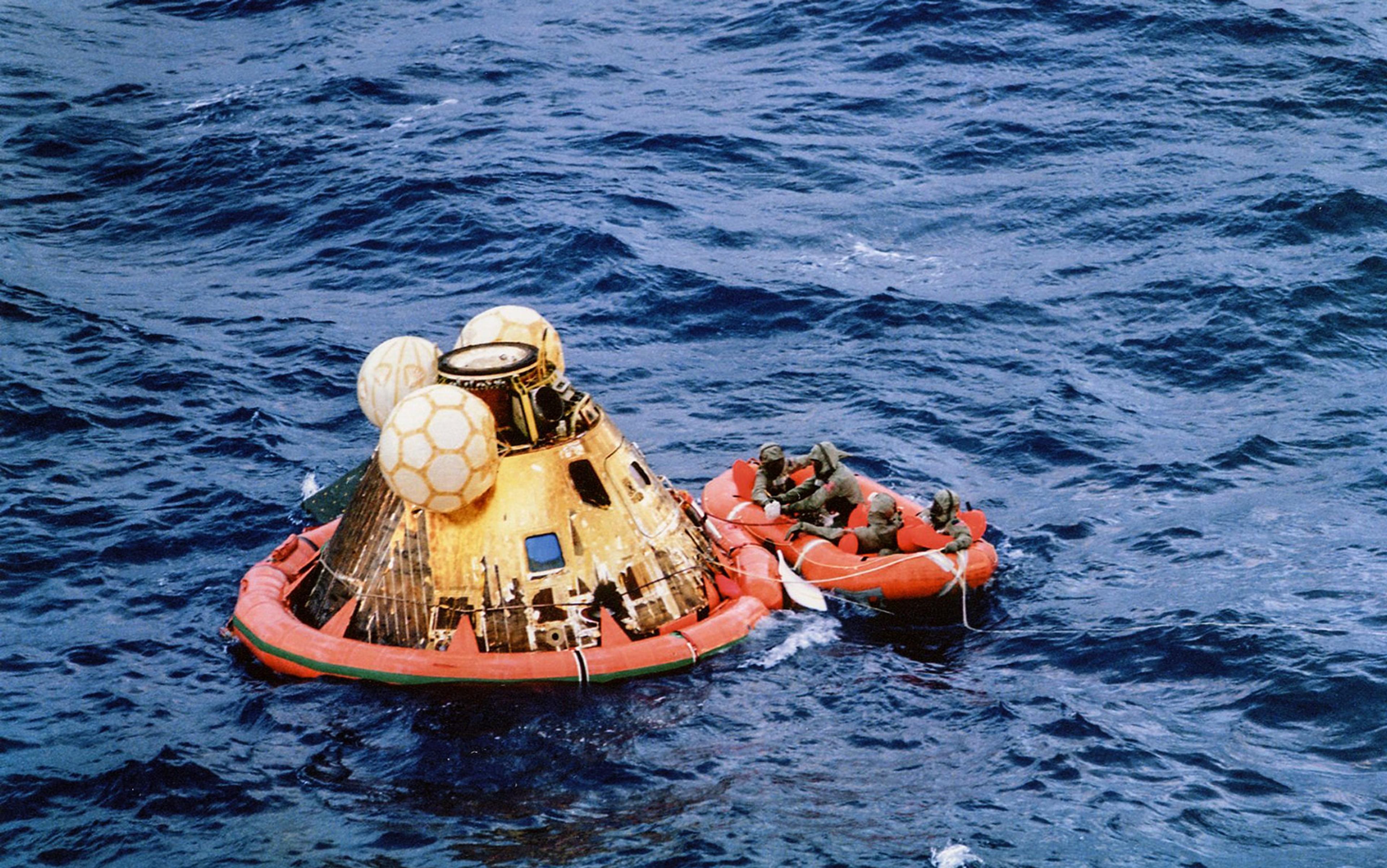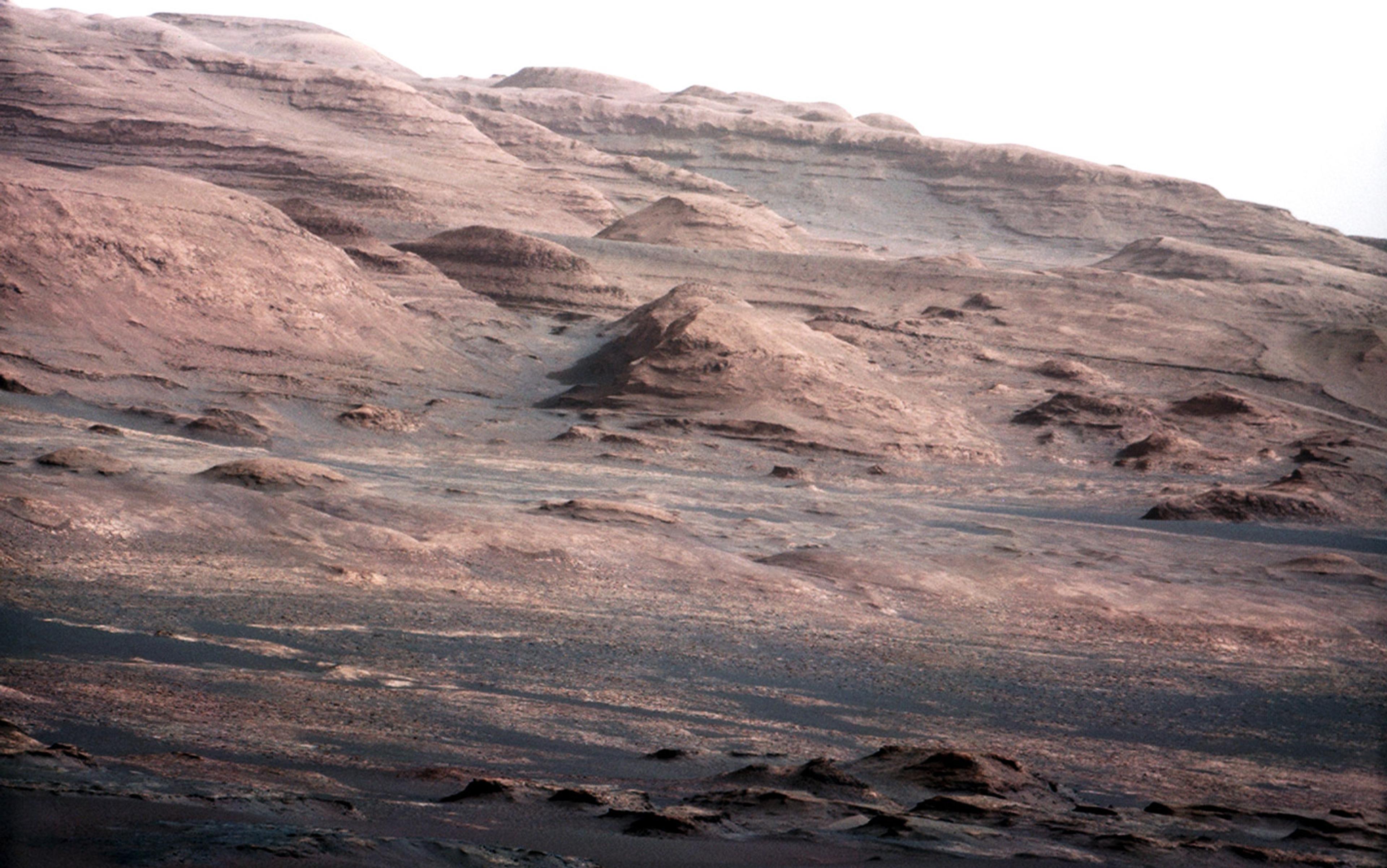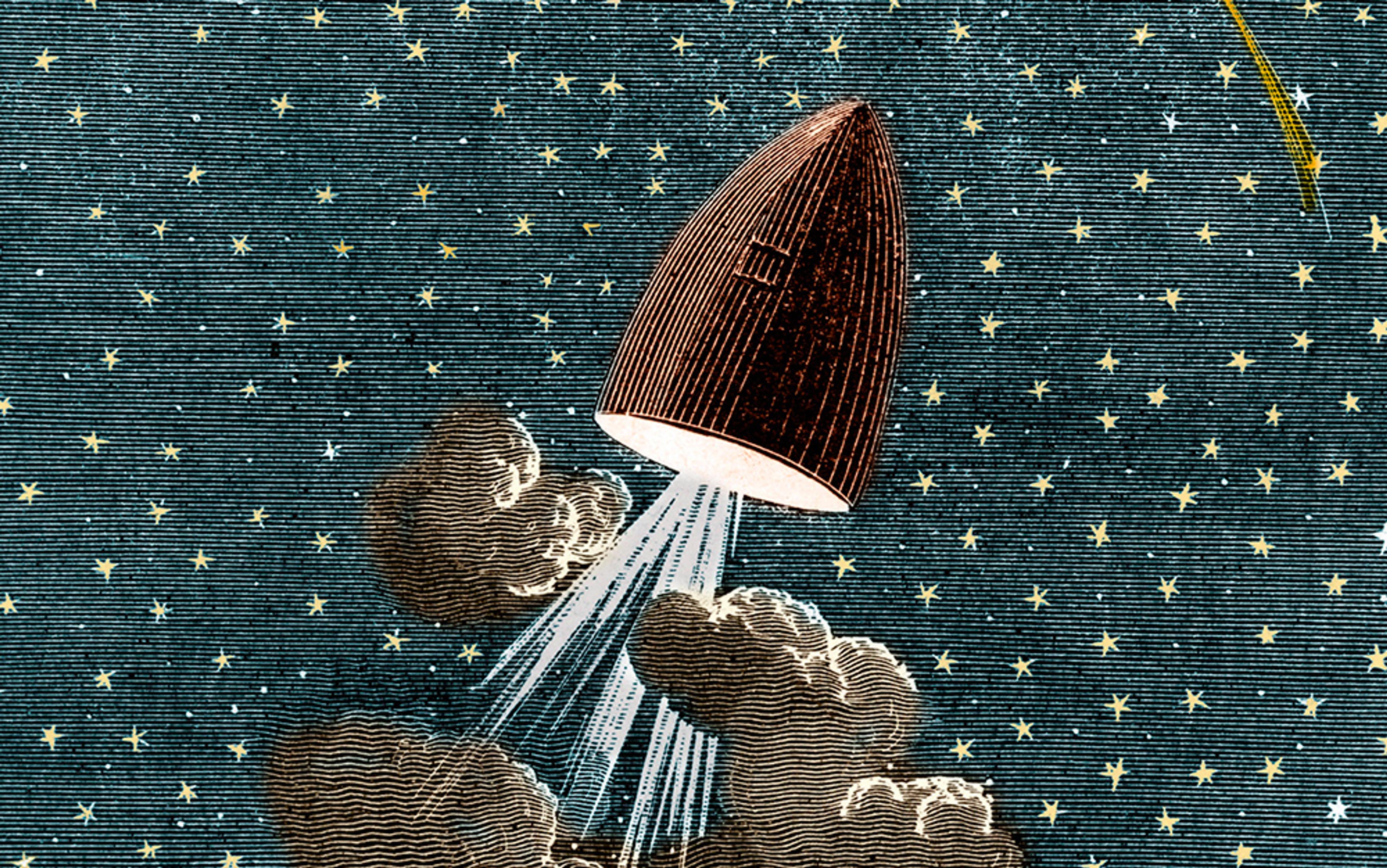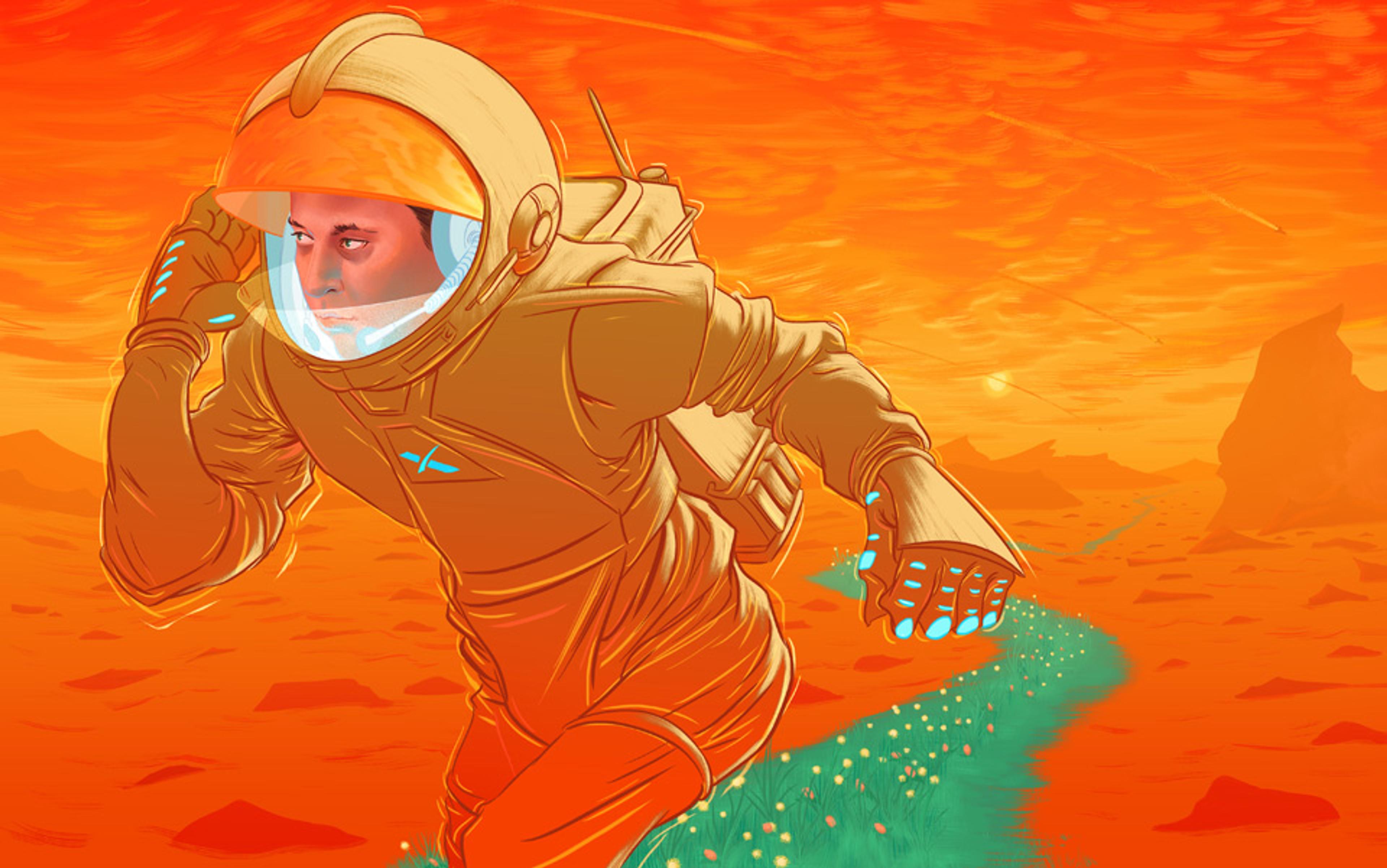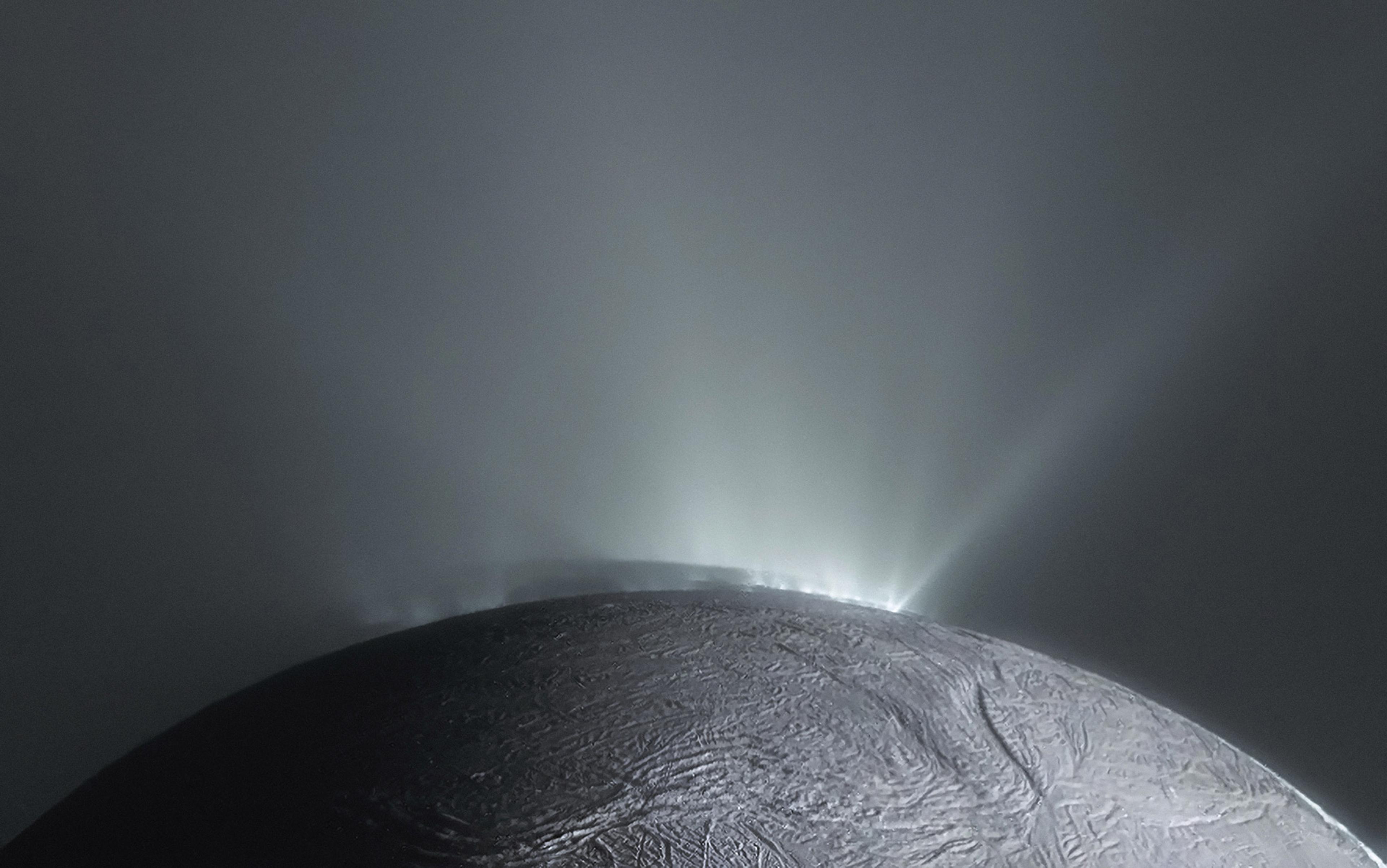In May 2020, as many of us stockpiled food and retreated indoors to escape the first wave of the COVID-19 pandemic, the American astronauts Robert Behnken and Douglas Hurley entered quarantine. In two weeks, they would lift off for the International Space Station, restoring the United States’ capacity to send humans into space. But now they waited, receiving only a trickle of visitors thoroughly screened for COVID. While a routine part of NASA’s long-standing ‘Flight Crew Health Stabilization Program’ (2010), their quarantine made headlines around the world. The astronauts, it seemed, were just like us.
NASA’s quarantine programme formally dates back to Apollo 14, the mission that would land the fifth and sixth astronauts on the Moon in 1971. Yet it really began with Apollo 11: the first lunar landing. Neil Armstrong, Buzz Aldrin and Michael Collins entered quarantine three weeks before lift-off in July 1969. Then as now, a pandemic – in that case, one caused by the H3N2 flu virus – swept across the country and, by July, tens of thousands of people had died.
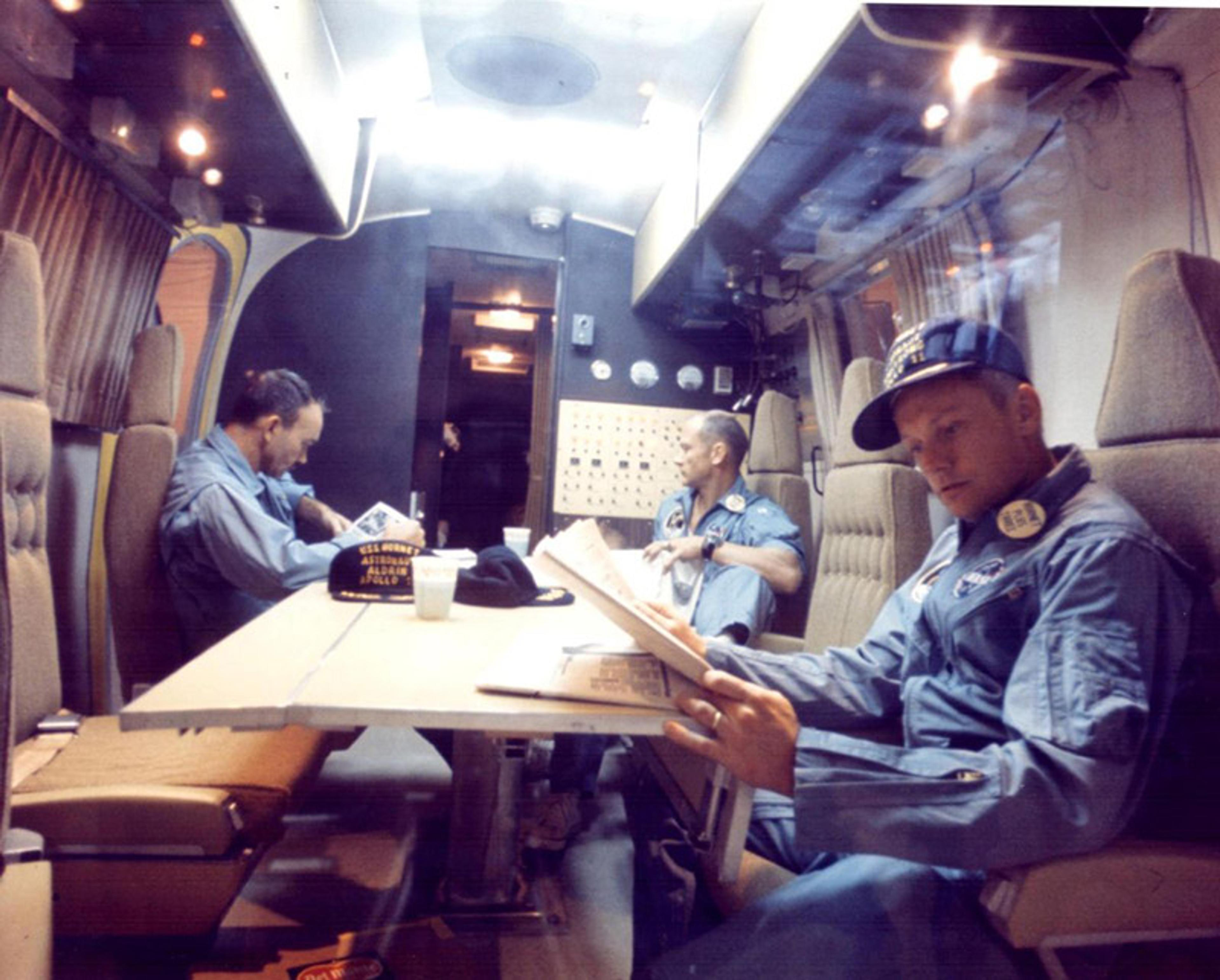
Michael Collins, Buzz Aldrin and Neil Armstrong relax within the mobile quarantine facility, a converted Airstream travel trailer onboard the USS Hornet to Pearl Harbor. Photo courtesy NASA
Yet for some NASA officials, the quarantine’s primary purpose had nothing to do with keeping the astronauts safe in space. ‘If they caught something pre-flight,’ one senior administrator fretted, ‘we would spend forever trying to convince everybody [after the mission] that this was not some lunar organism.’ The last thing the agency needed, another official confided to Newsweek, was a ‘Moon plague panic’.
Hard as it is to believe now, in the summer of 1969, millions across the US worried that the returning astronauts would spark a lunar pandemic on Earth. Nor did their fears lack merit. Scientists, bureaucrats and engineers across the federal government and the major universities of the US had spent years preparing for that possibility. It was one potential outcome of what they called ‘back contamination’: the introduction to Earth of alien microbes that could multiply exponentially in our benign biosphere.
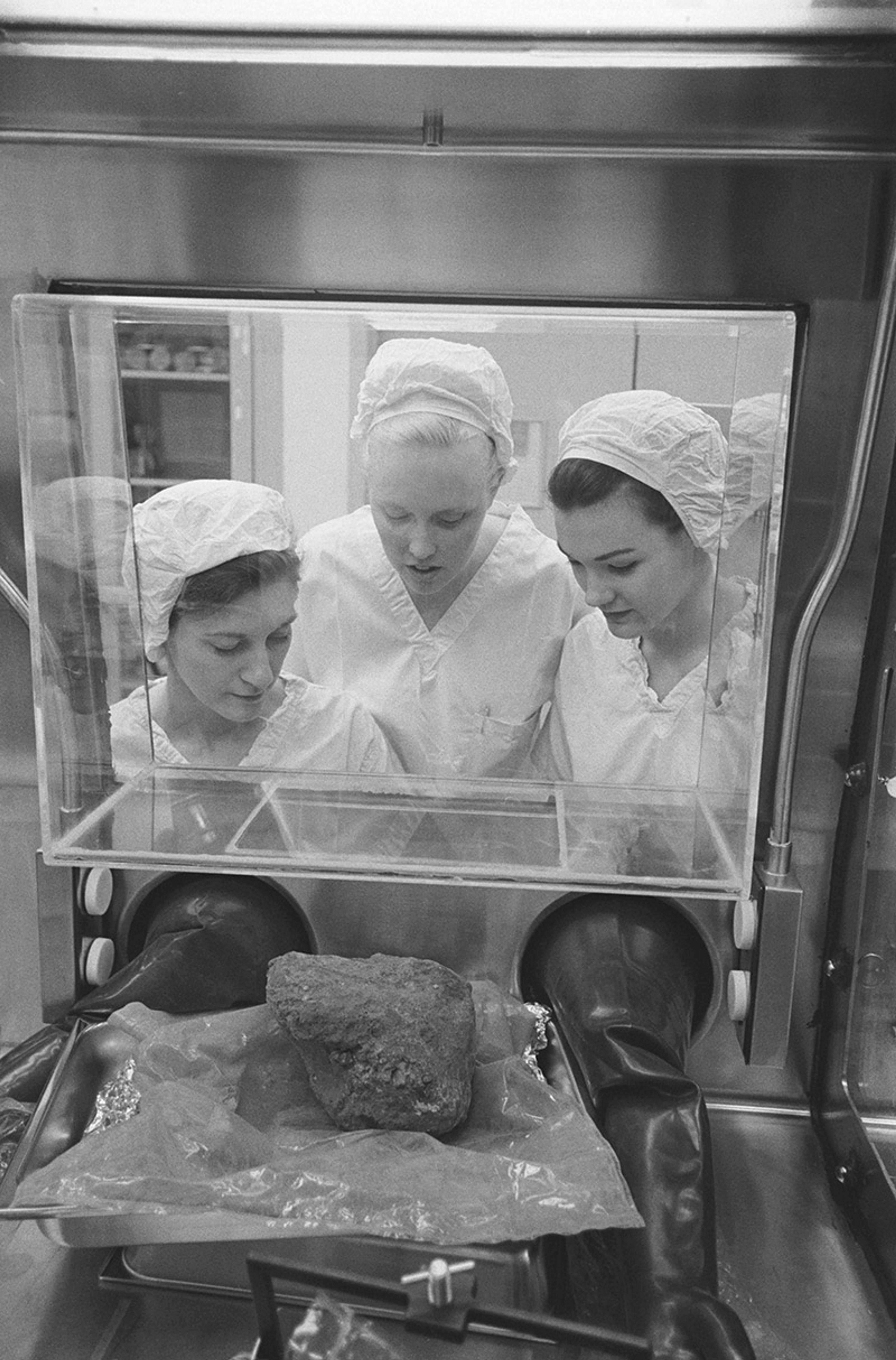
The technicians Linda Tyler, Nancy Trent and Sandra Richards at the Lunar Receiving Laboratory inspect the largest Moon rock collected by the Apollo astronauts. Photo courtesy NASA
Nobody knew for sure whether the Moon was really as dead as it seemed. Scientists speculated that life had evolved there at the same time as it emerged on Earth. A young Carl Sagan had warned that microbes could lurk just under the Moon’s surface, ready to infect unsuspecting astronauts. Grudgingly, NASA officials imposed a rigid quarantine procedure for astronauts returning to Earth. Its centrepiece was an enormous complex, the Lunar Receiving Laboratory (LRL), which would shield Moon rocks returned by the astronauts from terrestrial contamination – and prevent astronauts, rocks and spacecraft from contaminating Earth.
NASA reassured the public that its ‘unparalleled’ and ‘exhaustive’ preparations had left nothing to chance. Nothing could be further from the truth. In fact, every part of its quarantine procedure suffered disastrous breaches that would surely have exposed Earth to lunar microbes – had they existed. The microscopic universe, it turned out, was simply impossible to control.
In 1960 – nine years before Apollo 11 – the influential Space Science Board of the National Academy of Sciences (NAS) warned that lunar microbes could someday contaminate the Earth. Two years later, scientists at an NAS summer study in Iowa wrote that ‘destructive alien organisms’ introduced to Earth from other worlds could cause ‘a disaster of enormous significance to mankind’. That August, Sagan announced that the Apollo astronauts could set such a disaster in motion by retrieving organisms from the Moon.
While still an undergraduate at the University of Chicago, Sagan learned about the history of disease outbreaks from the historian William McNeill. Four years after the final Apollo mission, McNeill would publish a groundbreaking book, Plagues and Peoples, which chronicled the entangled history of human populations and the diseases that afflicted them. Now, McNeill’s lessons hit home. European explorers had repeatedly carried deadly Eurasian pathogens such as measles and smallpox to populations with no resistance or immunity, killing millions. Rarely – and controversially – they had also returned pathogens to Europe. To Sagan, there was a small chance that history could repeat itself – on a truly astronomical scale.
Congress paid heed. In early 1963, a congressional staff memo repeated Sagan’s warning that an outbreak from the Moon could resemble ‘the violence of the venereal disease epidemics that raged through Europe in the Middle Ages’, or perhaps ‘the measles that took a heavy death toll when it was introduced into Polynesia’. In April and May, senators bombarded NASA officials with questions about back contamination and the threat it posed to Earth. ‘Studies will be made,’ NASA representatives assured Congress, ‘and appropriate actions taken.’
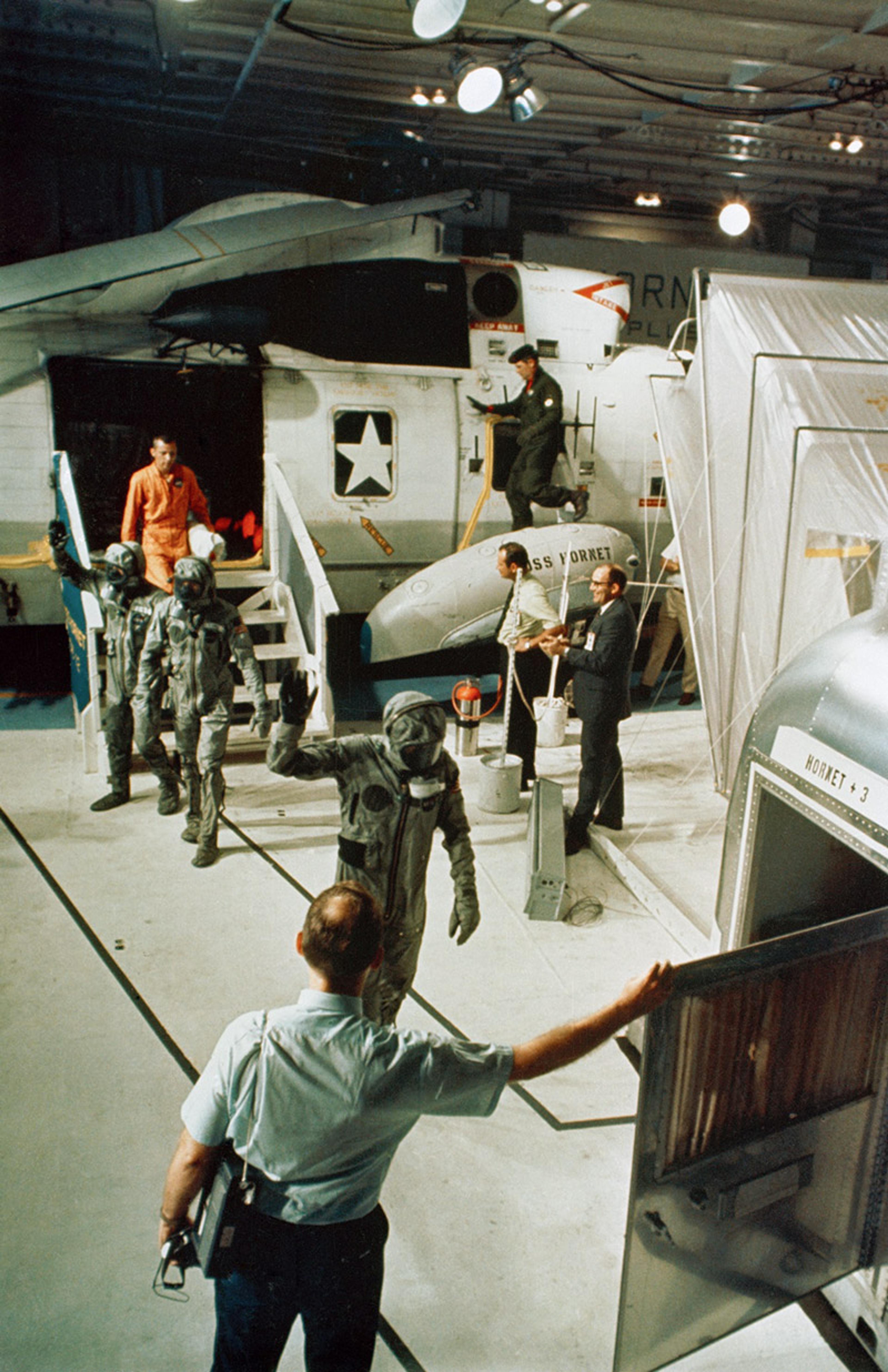
The Apollo 11 astronauts are transferred onboard the USS Hornet to the mobile quarantine facility. Photo courtesy NASA
Just over one year later, in July 1964, representatives from the Department of Agriculture, the Army, the National Institutes of Health, the Public Health Service, major universities and institutes and NASA held a two-day conference devoted to the threat. The stakes seemed high. Like Sagan, conference representatives pointed out that disease pathogens introduced to populations with no immunity had historically killed millions. They wondered: could lunar microbes do the same?
Yet the worst-case scenario was even more frightening. Organisms that seemed harmless on the Moon could ‘overgrow terrestrial life forms’ once introduced to Earth’s ‘comparatively lush conditions’, representatives warned, thereby transforming or even destroying the entire biosphere. Western thinkers had long assumed links between human wellness and the health of landscapes and environments – links that the growing environmental movement had, by the 1960s, made explicit in the US. Now, it seemed, those connections could become frighteningly clear.
To ensure that the astronauts didn’t harbour a slow-moving illness, the quarantine had to be at least three weeks long
Conference participants agreed that no procedure or technology could eliminate all organisms stowed away on returning spacecraft. They had to assume ‘that if infection of the Earth by extraterrestrial organisms is possible, it will occur.’ The key would be to prevent the organisms from escaping until a vaccine could be developed. The only way to do that would be to quarantine anything that returned from the Moon: and that meant not only astronauts but also the rocks they had collected and the spacecraft that carried them.
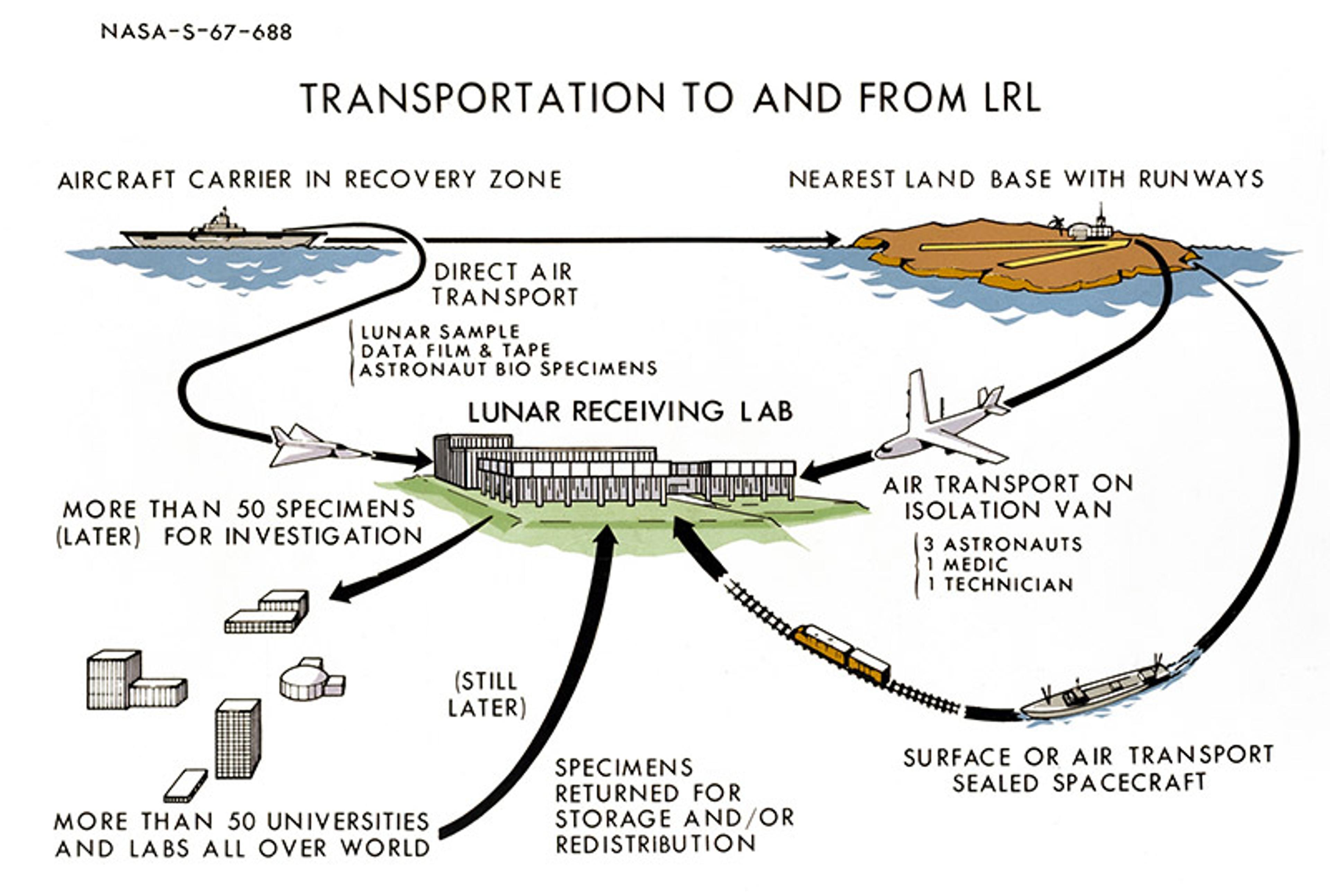
The Lunar Receiving Laboratory (LRL) at the centre of the quarantine plan. Image courtesy NASA
To ensure that the astronauts didn’t harbour a slow-moving illness, the quarantine would have to be at least three weeks long. And to verify that lunar microbes couldn’t contaminate the biosphere, some of the priceless rocks gathered by the astronauts would need to be ground to dust and exposed to plants, animals and tissue samples.
The conference marked the turning of the tide in American preparations for back contamination from space. It was now clear that NASA would need to design a facility that could not only protect Moon rocks from terrestrial contamination but also protect Earth from contamination by those rocks – all while conducting complex experiments using the rocks and maintaining a strict quarantine of everything else that had returned from the Moon, astronauts included. Nothing like the facility they would need had ever been imagined, let alone built.
After more than a year of bureaucratic squabbling, NASA planners settled on a design for an 86,000 sq ft laboratory. It would cost nearly $75 million to build, $60 million to equip, and more than $13 million annually to operate (all in 2020 US dollars). It would consist of three parts, each with a different function: a quarantine facility to isolate returned astronauts and spacecraft behind a biological barrier; a sample operations area to run experiments on Moon rocks and Earthly biota behind another barrier; and an administrative area.
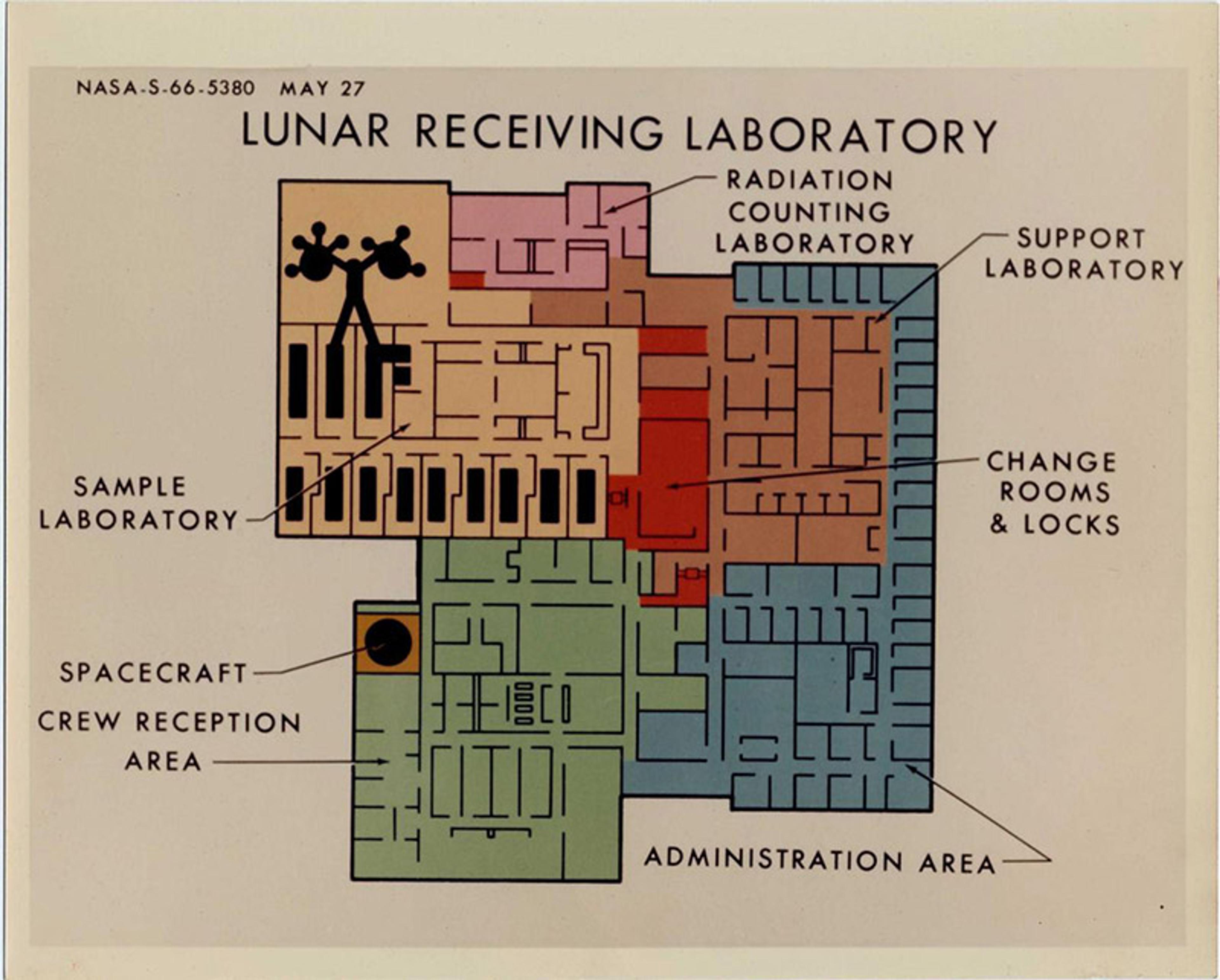
An early floor plan of the LRL. Image courtesy NASA
In the summer of 1965, NASA officials convinced representatives from the Public Health Service (PHS) that the new LRL could be located in the US, rather than some ‘isolated forward receiving station’ where non-Americans would be the first affected by a dangerous breach. In July, James Goddard, director of the Centers for Disease Control and Prevention (CDC), warned NASA that the PHS would not allow astronauts to return to the US without the facility. The surgeon general William Stewart and NASA’s administrator James Webb later agreed to establish a committee that would oversee NASA’s efforts to prevent back contamination.
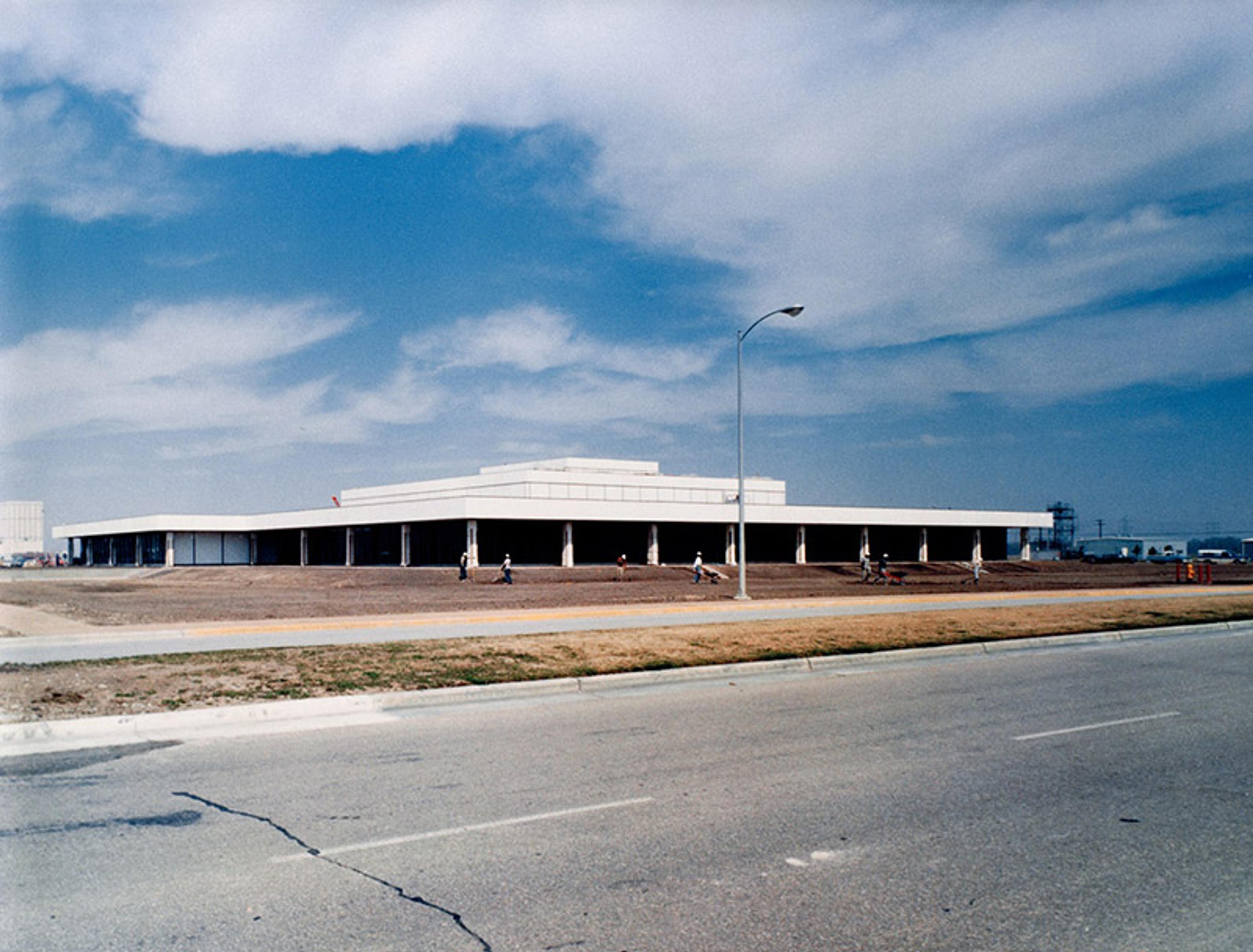
The LRL constructed at the Manned Spacecraft Center in Houston. Photo courtesy NASA
By March 1966, a new Interagency Advisory Committee on Back Contamination (ICBC) included two representatives from the CDC, nine from NASA and two each from NAS, the Department of Agriculture and the Department of the Interior. In theory, they would be responsible for establishing the procedures that NASA would follow to protect the Earth.
With PHS support, NASA managed to convince a sceptical Congress that the Apollo programme couldn’t continue without the new laboratory. Yet Congress delayed releasing the funds until August 1966, which left exactly three years before the first Moon landing. Somehow, the most complex scientific facility ever imagined would need to be built in no more than 16 months – to leave time for equipping, staffing, testing and certifying the complex.
Tensions quickly flared between geologists and chemists who wanted to study Moon rocks, and biologists who wanted to protect Earth’s biosphere. Geoscientists insisted that air pressure in the facility be higher than it was outside, so that air would flow naturally away from the rocks. That would help keep them free from terrestrial contamination. Yet it would also help lunar organisms escape. Bioscientists therefore demanded lower pressure within the facility, so that air would flow in – and towards the rocks. When they prevailed, geoscientists were enraged.
The LRL went up at miraculous speed, but by summer 1968, with just one year before Apollo 11, nobody had worked out how to test and certify the facility for use. That December, the chemist John Hodge led a new Operational Readiness Inspection Team that identified 140 deficiencies in the laboratory. It was nowhere near ready.
NASA administrators scrambled to respond. Yet the rush to test the facility suffered one disaster after another. The worst failures concerned the biological testing wing, where more than 100 species of plant and animal would be ‘challenged’ with Moon dust. In February 1969, a filter released mock contaminants into the parking lot. A minnow bred in ‘super-clean isolation’ died from a fungal infection. A ‘germ-free’ mouse died less than an hour later, apparently from a parasitic infection.
Technicians had to agree that, if exposed to lunar contaminants, their next of kin would not claim their bodies
During a simulation in March, every laboratory in the facility suffered a containment failure. Every single mouse died. The astrobiologist and NAS representative Wolf Vishniac reported that even ‘routine apparatus does not seem to work properly’. Autoclaves regularly filled with water, and there seemed to be ‘no way of carrying out rapid minor emergency repairs’.
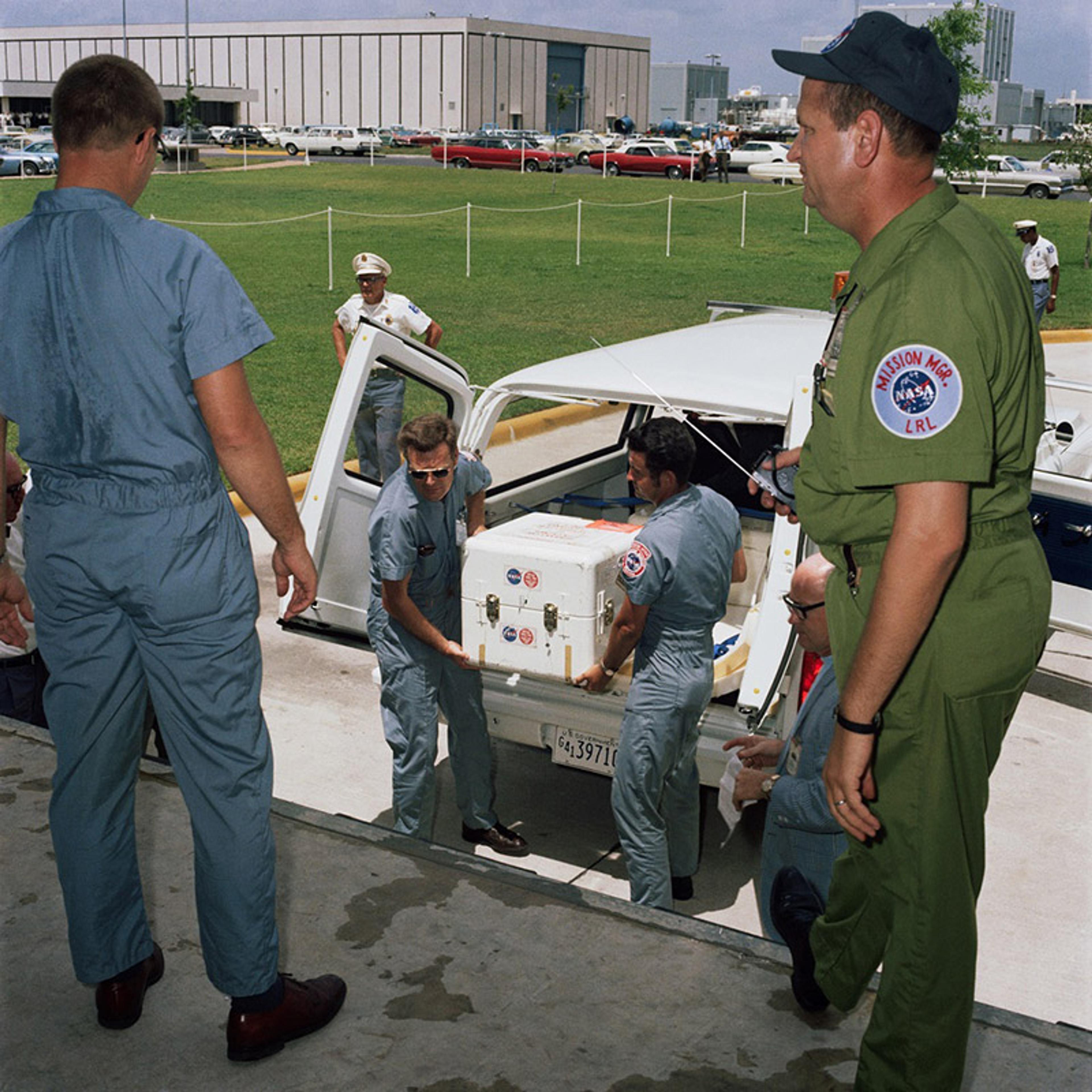
The first samples of Moon rock and dust are transferred to the LRL, July 1969. Photo courtesy NASA
NASA managers promised changes. Meanwhile, they hurried to recruit the laboratory’s staff. In the end, the LRL would require some 200 technicians to work alongside a hundred NASA employees and visiting scientists. Upon entering the facility, personnel had to remove their clothes and replace them with lab clothing. To prevent breaches, they would work closely with quarantine officers. When leaving, they would remove their lab clothes, shower, walk nude through ultraviolet light, and finally dress in street clothes.
To work in the LRL, technicians had to agree that they would not attempt to break out of quarantine if exposed to lunar contaminants, and that their next of kin would not claim their bodies upon death. In the event that dangerous lunar organisms breached the LRL’s internal barriers and threatened to escape the facility, NASA developed vague plans for armed guards to seal the facility at gunpoint and perhaps even bury it under a mountain of dirt and concrete.
The ICBC designed its contamination safeguards around the deadliest pathogen they could find: Yersinia pestis, the bacterium responsible for the bubonic plague. It was a bizarre choice. Y pestis is a complex bacterium, highly responsive to environmental conditions on Earth and adapted to a very specific organism: Xenopsylla cheopis, the tropical rat flea. Y pestis spreads zoonotically from fleas to humans – precisely the kind of transmission that bioscientists didn’t anticipate for lunar microorganisms; moreover, this microbe doesn’t generate the spores that could help bacteria survive near the lunar surface.
Hodge therefore suggested using a different pathogen to test the completed LRL: Coxiella burnetii, the tiny bacterium that causes Q fever in humans. C burnetti can form spores and is therefore resistant to environmental extremes. It is highly infectious, capable of sickening hosts with fewer than 10 individual bacteria, and it spreads readily by aerosol transmission. What mattered, Hodge realised, wasn’t the deadliness of the pathogen used to design and test the LRL, but rather how easily it could breach containment and how long it could endure hostile conditions.
NASA managers bitterly protested the idea of testing the facility with a live, hazardous agent, and even the ICBC recommended against a test that could well sicken thousands, including essential NASA employees on the eve of the first lunar landing. A high risk to the Apollo programme, it seemed, outweighed a small risk to Earth.
Until 1968, journalists and, in turn, the public largely ignored NASA’s efforts to prevent back contamination. Then, in the summer of 1968, a novel influenza virus, H3N2, emerged in Southeast Asia and first attracted Western attention in Hong Kong. By then, it had become a pandemic. The US outbreak would be among the worst in the world, with a surge of mortality between November and February that left around 100,000 people dead. Then as now, during the COVID-19 pandemic, people over 65 were most likely to die.
With deaths from a real pandemic surging across the US, popular attention turned to the threat of an even deadlier contagion from an even more distant origin. In late 1968, a wave of articles on the LRL and the threat of a lunar plague appeared in major newspapers and magazines in the US. Yet what really focused popular attention on the threat of back contamination was the publication of Michael Crichton’s thriller The Andromeda Strain (1969). In the book, scientists struggle to contain an extraterrestrial pathogen in a facility that Crichton explicitly modelled on the LRL. The Andromeda Strain rocketed up the New York Times bestseller list and prompted another wave of articles in the country’s major periodicals.
Anxious Americans sent thousands of letters to NASA, most of which expressed fears that we rarely associate with the Moon landings. In recent decades, psychologists have accumulated convincing evidence that feelings of disgust and horror associated with the threat of infectious agents can be so profound that they warp how people perceive reality. Besides prompting strong emotions, the presence of a contagion can prompt hostility towards the unusual and unknown – and perhaps the kind of exploration embodied by the Apollo programme.
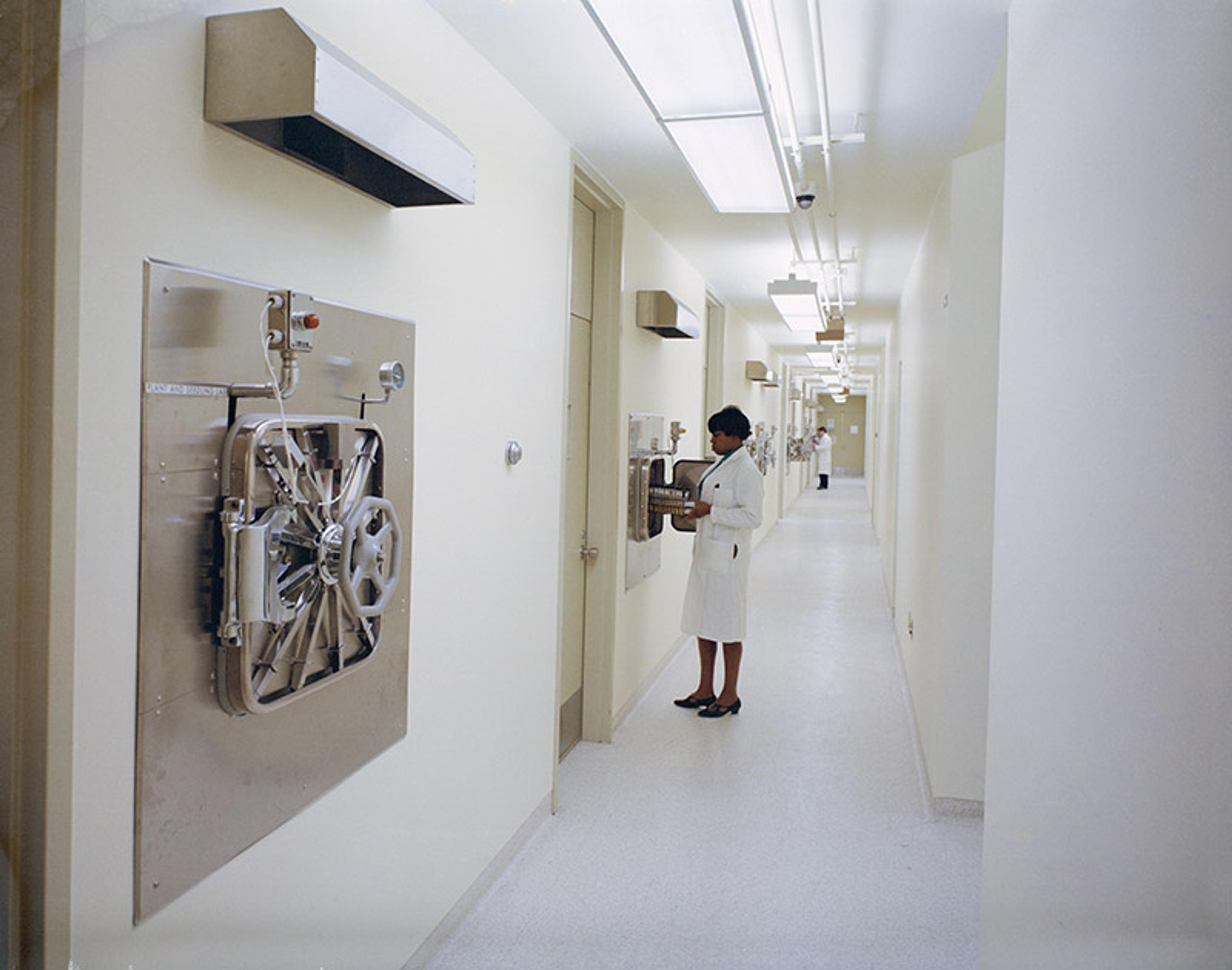
Scientists in the LRL sample operations area of the Biological Test Laboratory, 1968. Image courtesy NASA
NASA meticulously cultivated its image in popular media, and now the agency’s administrators felt compelled to arrange a press conference. In June 1969, Air Force Colonel John Pickering, director of lunar receiving operations, assured the media that NASA had worked closely with the ICBC to develop facilities and procedures that were well beyond the current state-of-the-art.
In fact, the ICBC had by then identified serious breaches in the quarantine protocol that NASA had designed to prevent a breach before the astronauts arrived in the LRL. According to the protocol, the capsule that returned the astronauts to Earth would need to be totally sealed once it entered the atmosphere. After splashdown in the Pacific Ocean, it would be hoisted by crane aboard an aircraft carrier. There, an impervious tunnel would allow the astronauts to walk into a mobile quarantine facility: a retrofit Airstream travel trailer. In the event of a breach, the carrier would remain at sea indefinitely.
If a lunar microbe made an astronaut sick, he would be removed from quarantine and brought to hospital
If all went well, the trailer and its astronauts would be offloaded with the capsule at Pearl Harbor, airlifted to Ellington Field Joint Reserve Base in Houston, and trucked to the LRL. There, another impervious tunnel would allow the astronauts to enter quarantine with their capsule and rocks. If the plane carrying them crashed, NASA planned to quarantine the crash site.
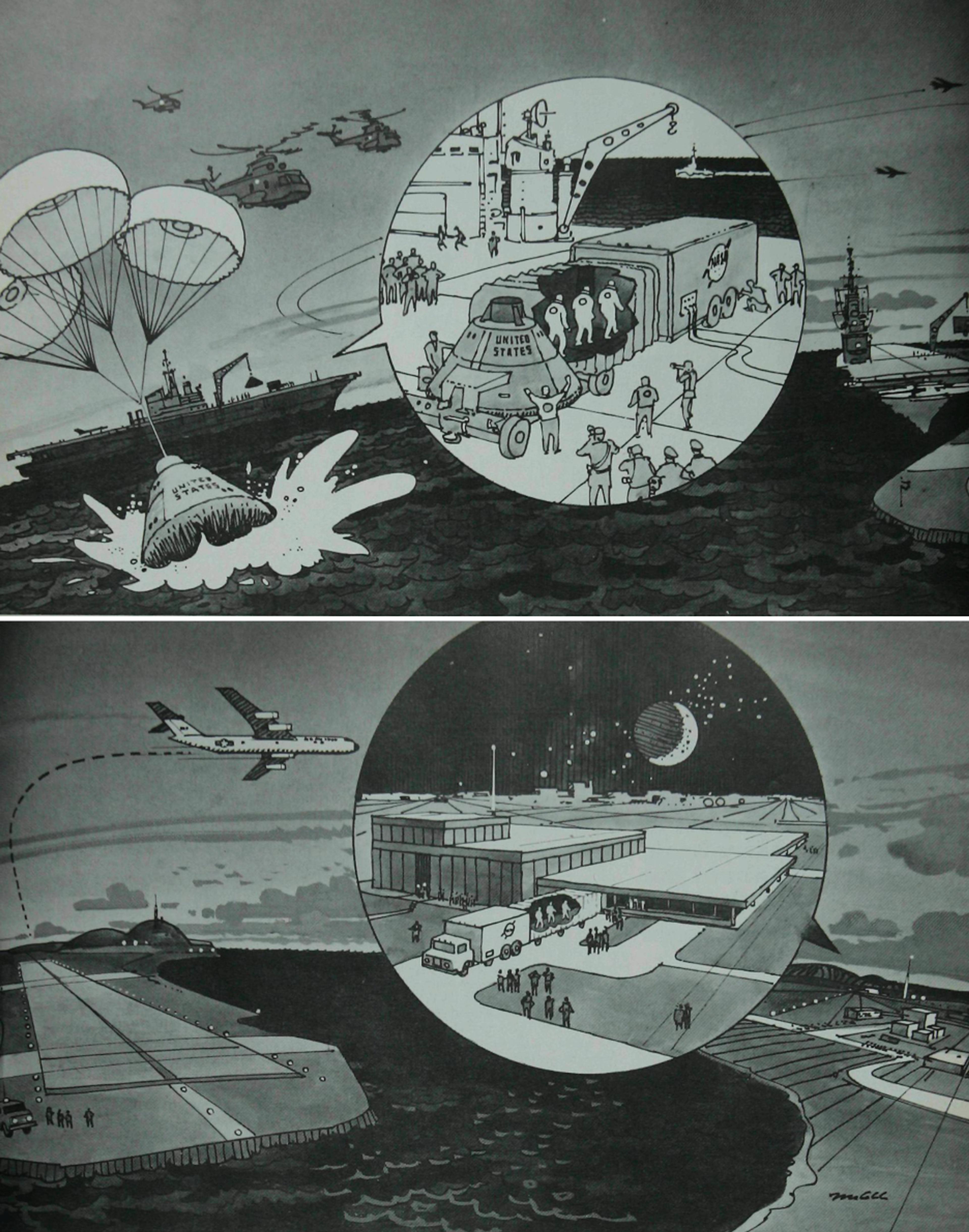
‘Welcome Home from the Moon!’: how a spread in The Saturday Evening Post of 2 November 1968 visualised NASA’s original plans for bringing astronauts, spacecraft and samples to the LRL. Photo courtesy The Saturday Evening Post archives
Yet to the consternation of some ICBC representatives, with months to spare, NASA officials decided that sealing the capsule threatened to suffocate the astronauts, and maybe even drown them once they splashed down. The only answer would be to vent the capsule in the atmosphere and then allow the astronauts to disembark at sea. The safety of the astronauts, NASA decided, overrode all else.
‘It is clear,’ Vishniac wrote to the president of the National Academy of Sciences, that ‘the Apollo Program is moving at a pace which we cannot stop,’ and that ‘this irresistible progress is being used to brush aside the inconvenient restraints … of the Quarantine Program.’ ICBC representatives now approached the press, and a wave of critical articles appeared.
With weeks before launch, NASA agreed to a new plan. The astronauts would now decontaminate their spacecraft, cleaning Moon dust using vacuums and filters. Navy divers would also toss biological isolation garments (BIGs) into the spacecraft that astronauts had to wear before disembarking. ‘All precautions are being taken,’ a NASA press release assured the public.
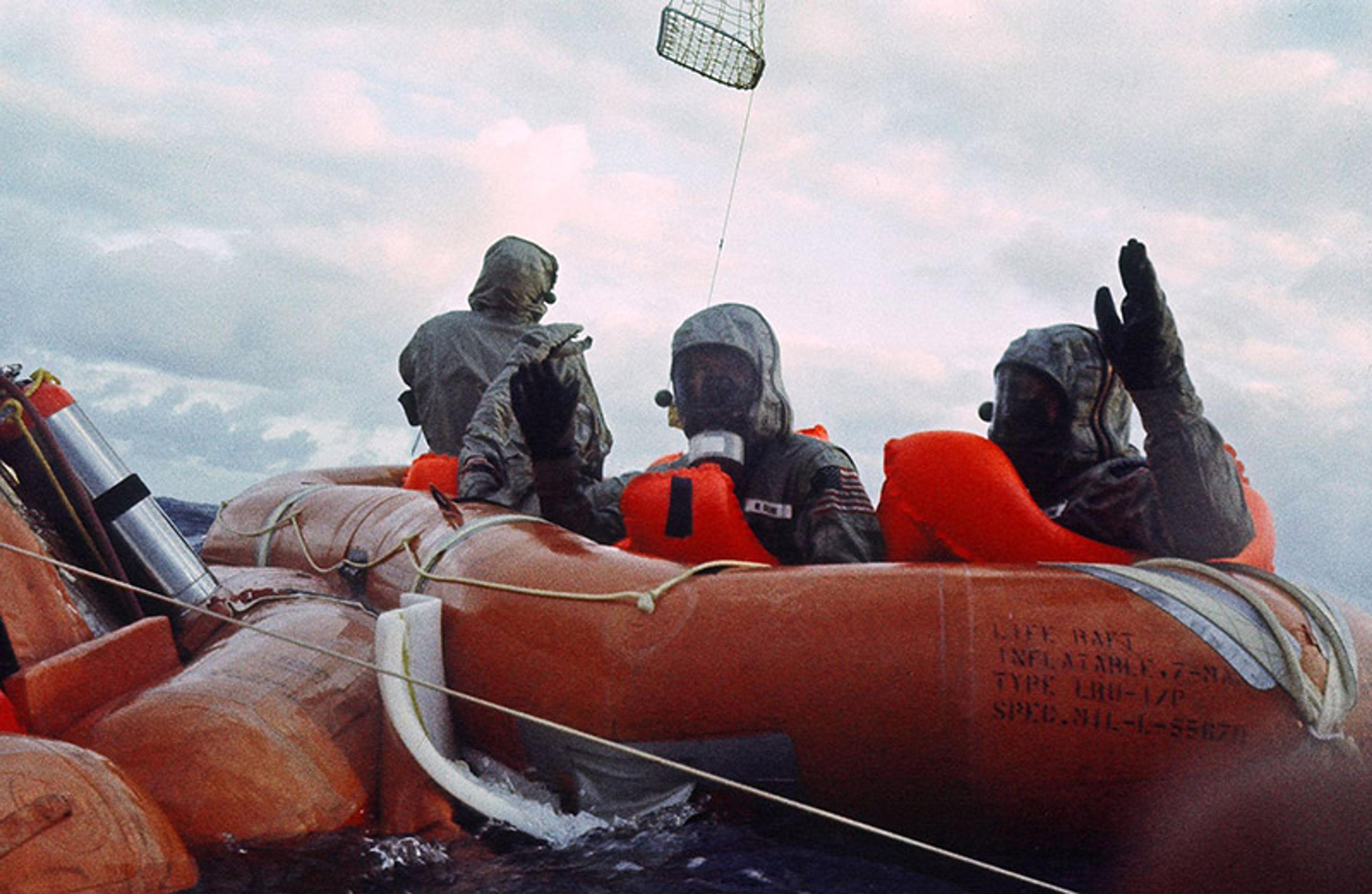
The astronauts were required to change into biological isolation garments immediately after splashdown. Photo courtesy US Navy/John Wolfram
Yet Sagan and the molecular biologist Cyrus Levinthal had identified an even more serious breach. NASA’s plans stipulated that quarantine at the LRL could be broken in the event of a medical emergency. Ironically, if a lunar microbe made an astronaut really sick, that astronaut would be removed from quarantine and brought to the hospital. It would have been the perfect way to launch a pandemic.
On 20 July 1969, Buzz Aldrin and Neil Armstrong landed in the Sea of Tranquility and opened the hatch of their lunar module. When they returned to sleep, they slowly pressurised their spacecraft. The moment they took off their helmets, they smelled Moon dust: a scent of ‘wet ashes’, according to Armstrong, or ‘the smell in the air after a firecracker has gone off’ to Aldrin.
The dust got everywhere. It irritated the skin. It was so pervasive that both astronauts slept in their helmets and gloves that night. Removing all the dust would clearly be impossible. Had the dust carried microbes, they would have easily infected the astronauts. It was only the first of many lapses, breaches and scares.
The US president Richard Nixon flew to the aircraft carrier that recovered the astronauts. If the astronauts fell sick, the presidential party was prepared to evacuate. It might not have done any good, however. The astronauts found saltwater in their isolation garments, suggesting that they leaked. Another breach had opened.
Then, shortly before the astronauts arrived to begin their three-week quarantine, the NASA photo technician and part-time opera singer Terry Slezak picked up a film cassette retrieved from the Moon and suddenly noticed his left hand was covered with something ‘very black … like graphite’. It was Moon dust. Slezak and five other men inside a sealed room had been exposed.

Terry Slezak shows the Moon dust on his hand before entering quarantine with the other technicians in the room, 25 July 1969. Image courtesy of NASA
Craig Fischer, chief of the LRL’s clinical laboratories, remembered that Armstrong had dropped a film magazine on the Moon. Sure enough, Slezak spotted a note from Aldrin, confirming that the magazine had directly touched the lunar surface. Now he wiped the magazine with a damp towel and put it through the decontamination procedure. After two hours, the technicians stripped, washed their hands and arms in sodium hypochlorite, showered for five minutes (the water drained into isolated septic tanks), and joined the astronauts in quarantine. Ten hours passed before NASA divulged the news to the press.
Reports written at the laboratory reveal that other breaches soon followed. On 27 July, a bag holding lunar samples sprung a leak, while the drain in the storage room that would soon house the command module overflowed. On 28 July, a biocabinet glove ripped open on a quail cage. On 29 July, technicians spotted gas bubbling from a bathroom fixture in the sample laboratory. On the following day, gas pressure in the drainage system caused urinals and drinking fountains to froth and bubble.
Had the astronauts or Moon rocks harboured a lunar pathogen, these breaches would have let it escape
Then, on 31 July, spacesuit gloves ruptured with ‘no warning’ and two more technicians joined the astronauts in quarantine. On 2 August, an instrument punctured another biocabinet glove, and then on 3 August pressures abruptly equalised in the laboratory’s vacuum chamber. On 5 August, sewer lines in a men’s lavatory started bubbling, and LRL medical staff decided to keep three men under daily observation.
The next day, a leak in the vacuum line of an autoclave sprayed three men and one woman with contaminated liquid. Since there were now 19 people in quarantine – including the astronauts and support staff – NASA concealed most of them from the public. Had the astronauts or Moon rocks harboured a lunar pathogen, these breaches would have let it escape.
There is little evidence that the quarantined felt the fear that had gripped the letter writers in the weeks before the Moon landing. ‘We were stuck in isolation,’ Armstrong remembered, ‘but I never found it unpleasant.’ Quarantine provided a welcome reprieve from the avalanche of public interest outside.
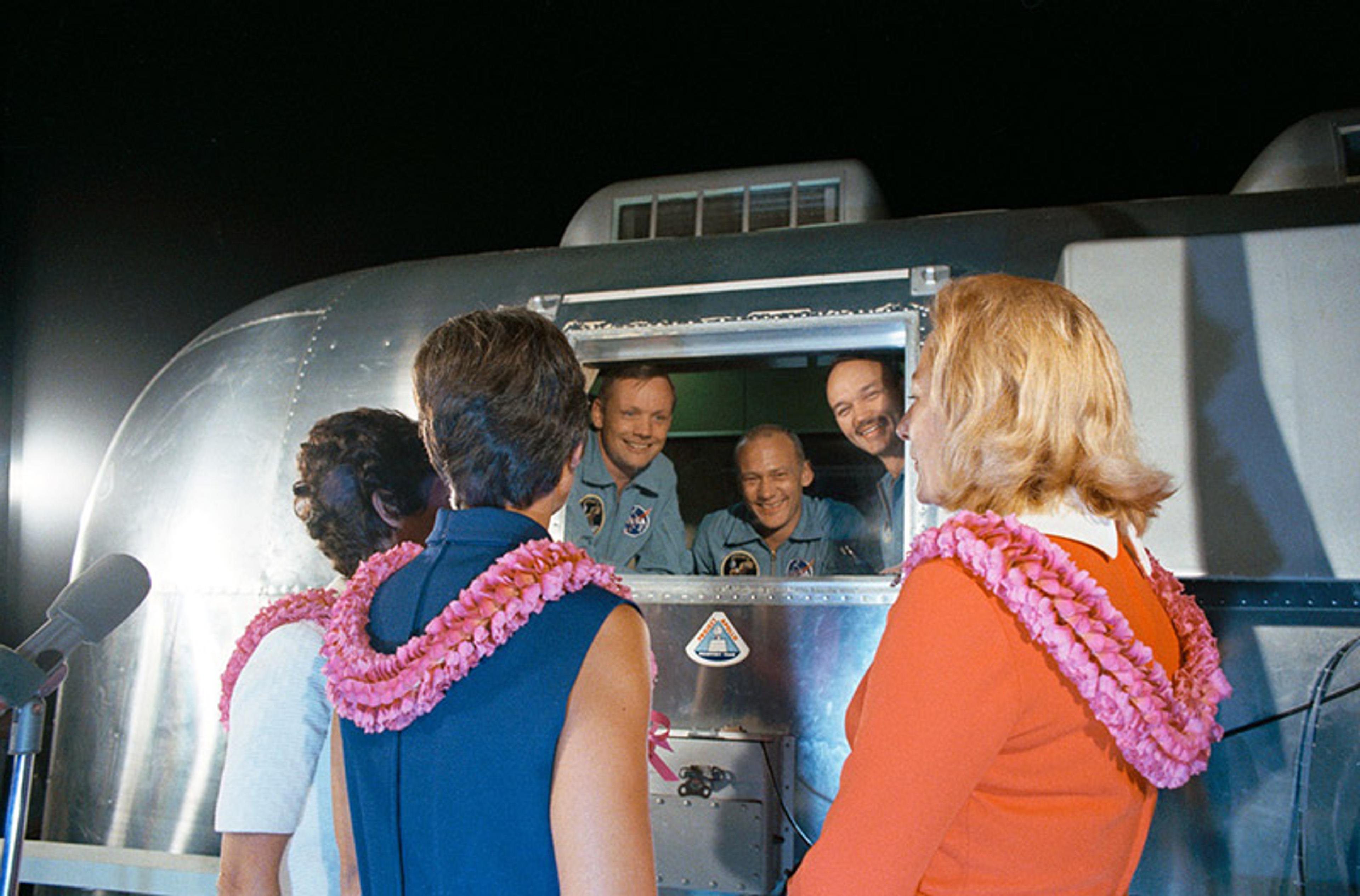
The wives of the Apollo 11 crew members were allowed to visit during quarantine. Photo courtesy NASA
If the worst the quarantined felt was frustration, not fear, that was because the most significant result returned by biological tests was that plants grew faster when exposed to the Moon dust. Even these unexpected findings generated headlines, and officials took pains to emphasise that they didn’t reveal the influence of an unknown lunar organism. Elemental nutrients in Moon dust had never encountered water, and were therefore easy for hungry plants to absorb.
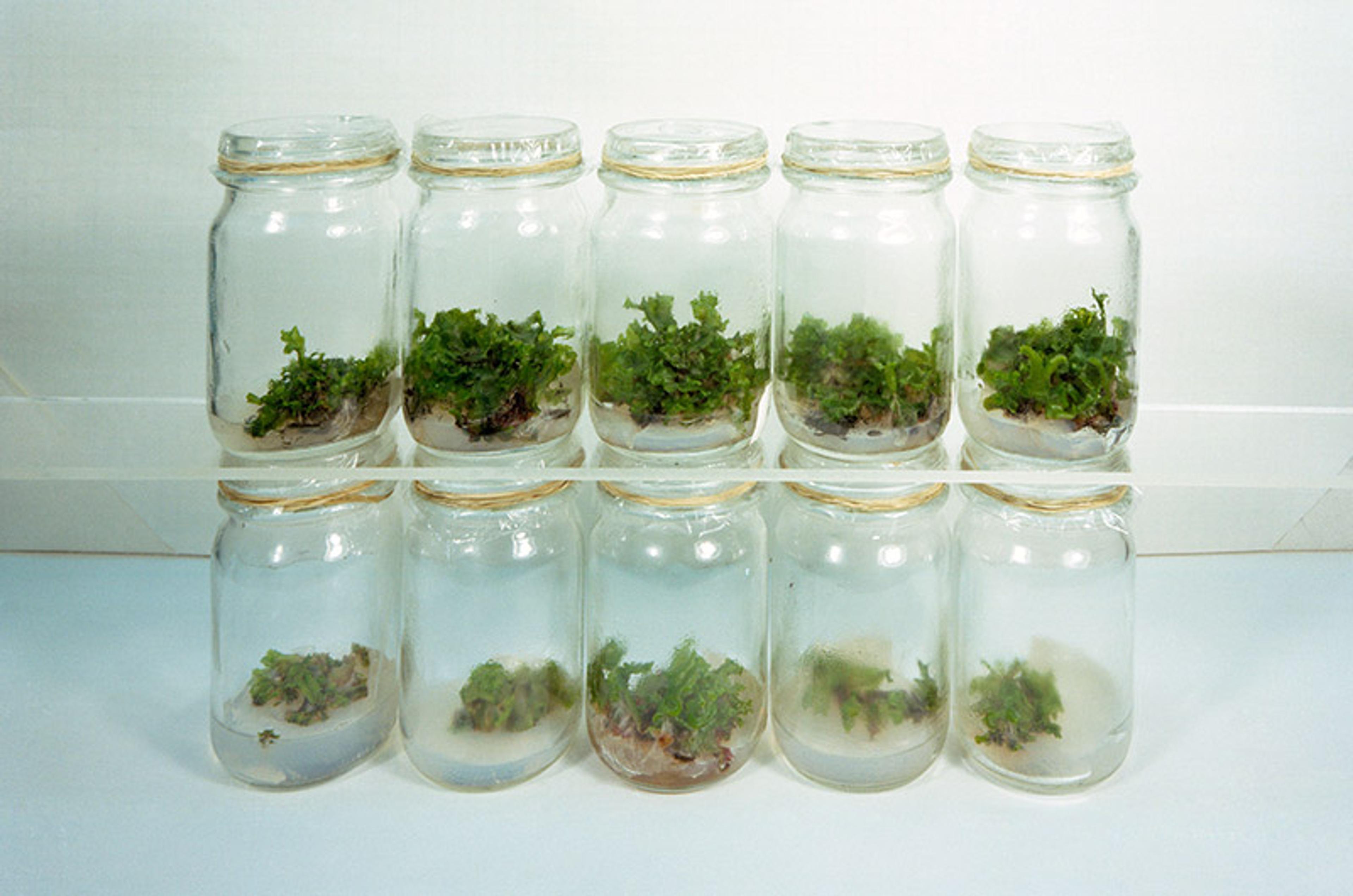
Plants grew faster when cultivated in Moon dust. Photo courtesy NASA
Quarantine for the astronauts ended three weeks after landing and, that November, Pete Conrad piloted Apollo 12 to touchdown within sight of a robotic lander, Surveyor 3, that had arrived on the Moon more than two years earlier. The astronauts had shown that they could land the lunar module with pinpoint accuracy: a requirement for future missions. After Conrad detached the probe’s camera so scientists on Earth could study how equipment endured the lunar environment, the astronauts returned to the lunar module for their night on the Moon.
‘Man, we are filthy!’ Conrad exclaimed.
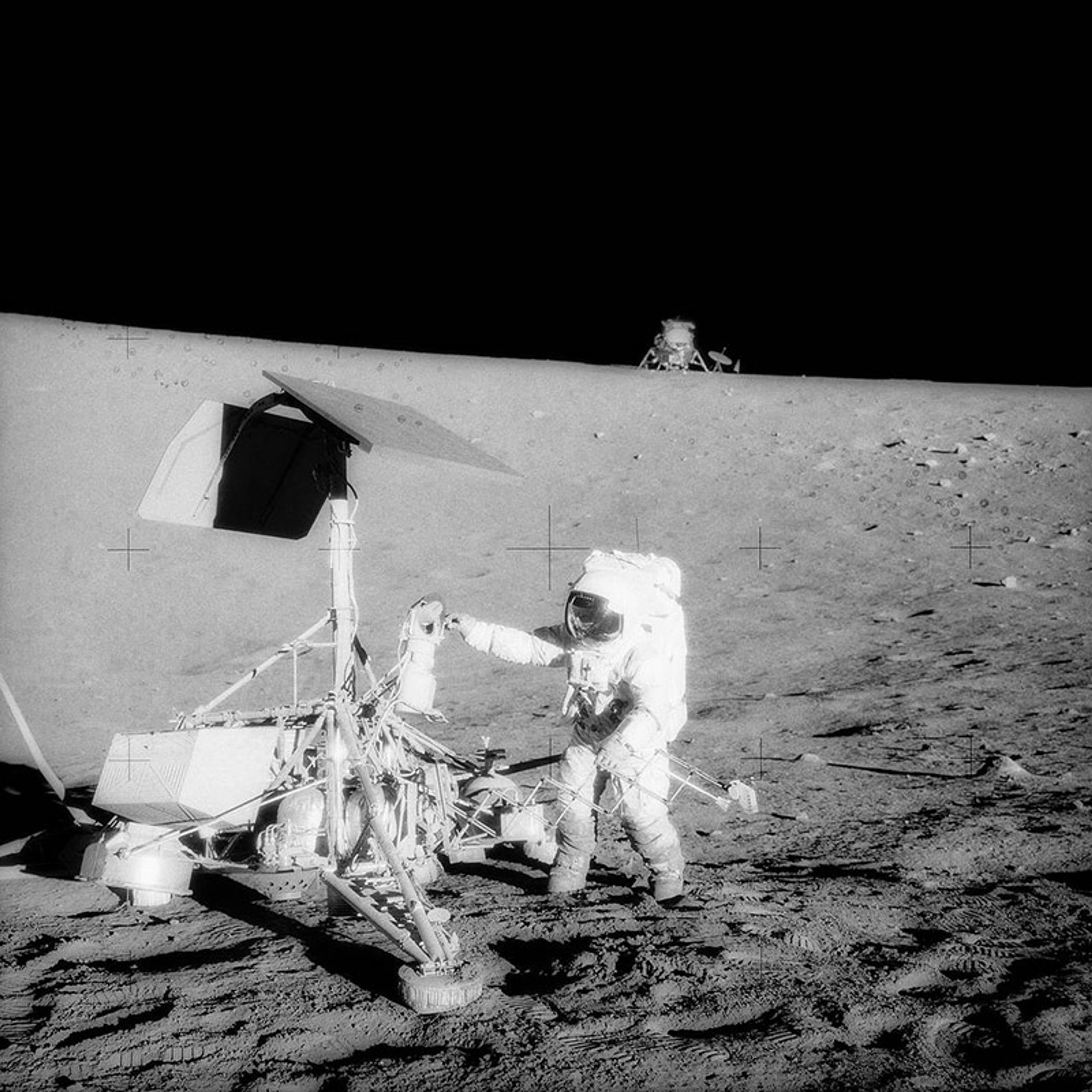
Pete Conrad examines the Surveyor 3 camera before detaching it, 20 November 1969; the Apollo 12 lunar module is in the background. Image courtesy of NASA
After these astronauts, too, entered quarantine, more breaches plagued LRL. Again, word never reached the public. When a technician’s glove ripped, no fewer than 11 geologists joined the astronauts in containment. Few if any geologists feared a lunar contagion, and many resented the quarantine measures, concocted by biologists, that had made it so much harder for them to study their precious Moon rocks. Behind the biological barrier, these geologists were a rowdy bunch. ‘It got so bad one night,’ Conrad remembered, that ‘I had to go in and tell them to shut the hell up.’
Then, in spring 1970, two discoveries at the lab made headlines across the US. First, in March, microbiologists in the LRL exposed bacteria to Moon dust exhumed from below the lunar surface by the Apollo 11 astronauts. Within 10 hours of exposure, NASA reported, all bacteria were dead. Time magazine announced an ‘unknown killer in the Moon soil’. NASA officials agreed to continue the quarantine protocol for Apollo 13 – which, of course, never reached the lunar surface.
Two months later, LRL scientists found bacteria in the Surveyor 3 camera housing: precisely the result the committee on back contamination had feared. Further tests revealed it to be Streptococcus mitis: a benign species, well-known on Earth, that resides in the human respiratory system. At the time, scientists concluded that a technician had contaminated the probe’s camera by breathing on it before it launched into space. Rather than evolving into something more threatening, as Crichton had predicted, the bacteria had apparently survived for years on the Moon without changing.
‘I always thought the most significant thing that we ever found on the whole goddamn Moon,’ Conrad later reflected, ‘was that little bacteria who came back and lived and nobody ever said shit about it.’
If pathogenic microorganisms did exist on the Moon, NASA wouldn’t have contained them
Perhaps. Studies have since shown that bacteria can indeed survive for years in the near-vacuum of space. Yet conditions in the LRL were so lax that scientists testing the camera housing could simply have detected their own bacteria.
What is clear now is that, if pathogenic microorganisms did exist on the Moon, NASA wouldn’t have contained them. They could have infected astronauts on the Moon; they could have escaped the Apollo capsule above or on the Pacific Ocean; they could have breached containment in the LRL. Far from incompetent, NASA engineers and scientists had been forced to undertake an impossible task. Even those who appreciated the risk posed by back contamination understood that, ultimately, no containment system could ever be foolproof. A dangerous pathogen brought to Earth from space would inevitably escape. It was only a question of when.
Today, NASA, the European Space Agency and the China National Space Administration are all preparing robotic missions that would return samples to Earth from Mars, a world far more likely to harbour microbial life than the Moon. Enduring mysteries about the richly complex atmosphere of Venus have also inspired plans – by space agencies and companies – for a sample-return mission to that world.
Microbial life on either world would have no familiarity with human immune systems, and perhaps no way of infecting us. Yet meteorites have circulated across the inner Solar System, and Earth might be only the most fertile outpost in a biosphere of cosmic proportions. If so, we could be vulnerable to microbes from other worlds.
In July 2020, NASA issued a directive defining its obligation to protect Earth from Martian back contamination. Yet the history of NASA’s lunar quarantine suggests that it might not be possible to contain harmful microbes from Mars or Venus, once they arrive on Earth. Amid a pandemic even deadlier than the H3N2 outbreak in 1968, we would be wise to carefully consider the risks. It would be slower and costlier to study Martian life on Mars, or Venusian life on Venus – but history suggests it could be safer. If COVID-19 has taught us anything, it might be that we have less control over the microbial world – or worlds – than we think.
